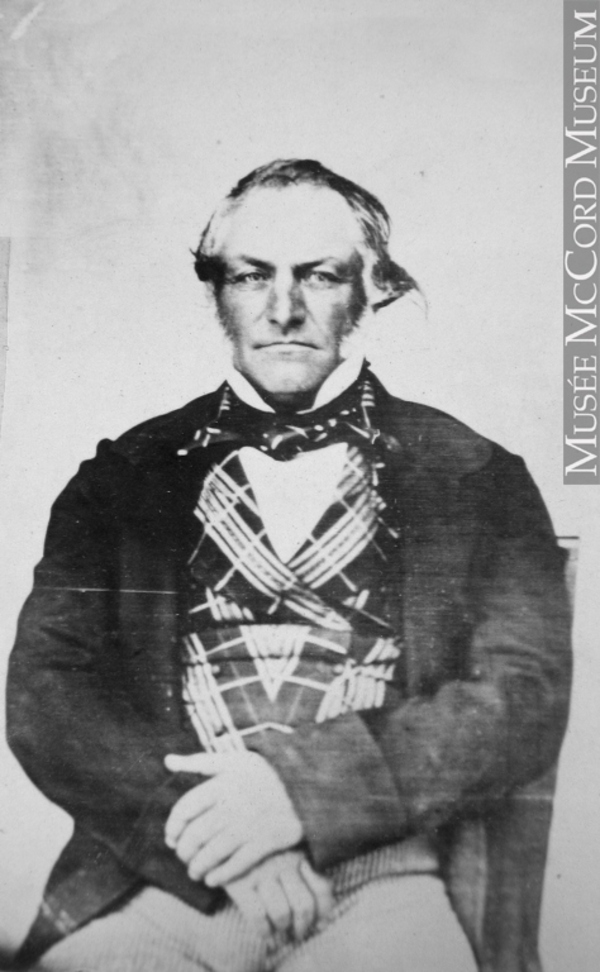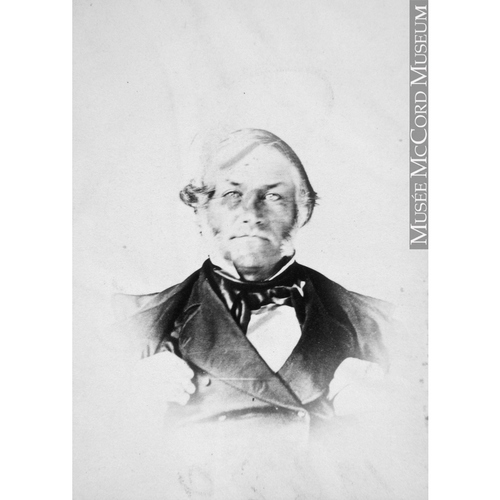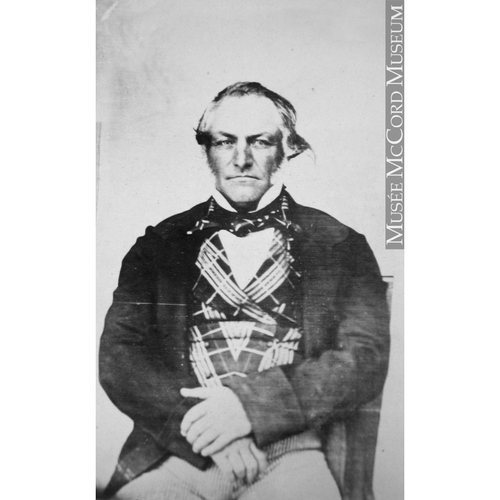
Source: Link
BUNN, JOHN, doctor, councillor of Assiniboia, and magistrate; b. probably in 1802 at an HBC post on Hudson Bay, son of Thomas Bunn and Sarah McNab who was of part-Indian blood; d. on 31 May 1861 at Red River; an Anglican, he was buried in St John’s Cathedral cemetery.
Most of John Bunn’s early childhood was spent with his family at York Factory (Man.) where his English-born father was employed as a writer by the Hudson’s Bay Company. Whatever uncertainty the death of his mother in 1806 brought into his life, young John was well cared for by his father and by his Scottish grandfather, John McNab, a surgeon and the chief factor at York Factory. Thanks to their generous assistance, he attended a good school in Edinburgh and then began to study medicine at the University of Edinburgh. In 1819, when he had only two years’ medical training, not enough to graduate, he was persuaded by McNab to accept a position as surgeon at Moose Factory. Upon reaching Moose Factory in September of that year, Bunn had grave misgivings about the wisdom of his grandfather’s decision in sending a not yet fully qualified doctor into the wilderness of Rupert’s Land. Uneasy as he was about his future, during the next five years Bunn gained considerable experience by serving the HBC as a surgeon at several posts as well as on the company’s ship, the Eddystone.
With no real taste for a nomadic existence, Bunn in 1824 left the HBC service and moved to the Red River Settlement to begin a private medical practice. Here, in the vicinity of Middlechurch, he lived with his father who had retired two years earlier. Here too, on 23 July 1829, he married Catherine Thomas, the daughter of his father’s close friend Thomas Thomas*, a former governor of the Northern Department. Because of his family connections and his professional status, Bunn was able to move easily in the influential circles of Red River society. A witty, good-natured, and vigorous man, with a dark complexion and a handsome bearing, Bunn the doctor was as popular with the HBC establishment as he was with the half-caste population of the settlement.
Feeling the need to upgrade his qualifications, Bunn again attended the University of Edinburgh during the 1831–32 academic session, and returned to Red River in 1832 not with a degree but as a licentiate of the Royal College of Surgeons at Edinburgh. He was happy to come home to his wife Catherine who had cheered him with her affectionate letters while he was abroad. A little over a year after his return, on 3 Jan. 1834, came her death, and he never remarried. He and his three small boys, one of whom was Thomas*, continued to live comfortably in his father’s household which was ably managed by his halfbreed stepmother Phoebe Sinclair Bunn.
From 1835, when he became a member of the Council of Assiniboia, until his death, John Bunn was usually the only doctor in the settlement, and he mingled his private practice with public medical work. Beyond his private earnings, he received from the council during this period an annual salary of £100 as compensation for his free services to the poor of Red River. In the absence of a hospital and a pharmacy, and with shortages of essential medicines and vaccines, Bunn found himself struggling to control the scourges of whooping cough, scarlet fever, influenza, measles, and cholera that made their appearance in Red River from time to time. Dressing cuts and bruises and setting fractured limbs, providing remedies for common colds, and calling upon sufferers in their homes, all were among his routine activities and helped to make him a highly respected family physician.
In addition to his concern for the health of the Red River community, Bunn, as one of the most active councillors of Assiniboia, played a significant part in local government. His work on the council, which he approached with a pragmatic outlook and with an intimate knowledge of the affairs of Red River, was intended to encourage the development of an orderly society and the cultural and material growth of the settlement. Partly through his strong support of Eden Colvile*, governor of Rupert’s Land, who regarded him as “the most sensible man in the Settlement,” the government of Assiniboia, which had collapsed under the administration of Major William Bletterman Caldwell* in the late 1840s, was again made effective. Besides steering the council into voting financial aid for the Red River Agricultural Association and for the expansion of educational facilities, Bunn during his tenure as chairman of the Board of Public Works from 1856 to 1861 induced the council to spend a good deal of money on the construction of roads and the bridging of streams tributary to the Red and Assiniboine rivers.
The HBC’s belief in John Bunn’s ability, integrity, and sound judgement – a belief shared by an overwhelming majority of the inhabitants of Red River – led to his appointment to a variety of legal posts: magistrate of the Lower District, 1837–1849; coroner of Assiniboia, 1849–1861; sheriff and governor of the jail, 1856–1861; and, finally, recorder of Rupert’s Land, 1858–1861, in which capacity he directed the proceedings of the General Quarterly Court of Assiniboia. In conducting the business of the recordership Bunn reached the height of his authority as a judicial administrator, and was faced with the most serious cases in Assiniboia. Individuals were brought before him in court for manslaughter, robbery, debt, and the illegal sale of liquor.
Diligent and conscientious in his many tasks, John Bunn drove himself at an exhausting pace. At the same time, he could relax and was fond of the merry Red River balls, and by reading professional journals and English newspapers he kept in touch with the medical field and the outside world. Proudly aware of his mixed English, Indian, and Scottish heritage, he was representative of important strands in the Red River civilization of the mid 19th century.
PAM, MG 2, C21, John Bunn to Donald Ross, 12 March 1848. Canadian North-West (Oliver), I, 61–62, 268–69, 280, 314, 353, 358, 360, 368, 387, 395–96, 420, 423–25, 430–31, 433–34, 446–47, 478. Hargrave correspondence (Glazebrook), 158, 181, 342, 452. HBRS, XIX (Rich and Johnson), c-cv, 24–25, 213–16. Mactavish, Letters of Letitia Hargrave (MacLeod), liv, 105, 143–44, 169–70. Nor’Wester, 1859–62. “Private letters from the fur trade,” ed. Clifford Wilson, HSSM Papers, 3rd ser., no.5 (1950), 28. Pioneers of Man. (Money et al.), 34–35. Denis Bayley, A Londoner in Rupert’s Land: Thomas Bunn of the Hudson’s Bay Company (Chichester, Eng., 1969), 14–15, 31–32, 39–40, 57–60, 62–63, 65–67, 69–71, 73–75, 88, 92–97. W. J. Healy, Women of Red River; being a book written down from the recollections of women surviving from the Red River era (Winnipeg, 1923), 26, 49–50, 201, 216–19. R. B. Mitchell, Medicine in Manitoba; the story of its beginnings ([Winnipeg, 1955]), 37–46. R. St G. Stubbs, Four recorders of Rupert’s Land; a brief survey of the Hudson’s Bay Company courts of Rupert’s Land (Winnipeg, 1967), 91–134. S. P. Matheson, “Floods at Red River,” HSSM Papers, 3rd ser., no.3 (1947), 13. E. A. Mitchell, “A Red River gossip,” Beaver, outfit 291 (spring 1961), 9, 11. Ross Mitchell, “Doctor John Bunn,” Beaver, outfit 269 (December 1938), 50–53; “Early doctors of Red River and Manitoba,” HSSM Papers, 3rd ser., no.4 ([1949]), 39–41.
Cite This Article
H. C. Klassen, “BUNN, JOHN,” in Dictionary of Canadian Biography, vol. 9, University of Toronto/Université Laval, 2003–, accessed March 25, 2025, https://www.biographi.ca/en/bio/bunn_john_9E.html.
The citation above shows the format for footnotes and endnotes according to the Chicago manual of style (16th edition). Information to be used in other citation formats:
| Permalink: | https://www.biographi.ca/en/bio/bunn_john_9E.html |
| Author of Article: | H. C. Klassen |
| Title of Article: | BUNN, JOHN |
| Publication Name: | Dictionary of Canadian Biography, vol. 9 |
| Publisher: | University of Toronto/Université Laval |
| Year of revision: | 1976 |
| Access Date: | March 25, 2025 |




